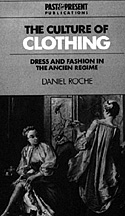
This book is an English translation of La Culture des Apparences
 Author: Daniel Roche
Author: Daniel Roche
Pages: 549
Illustrations: 10 black and white reproductions of period paintings and illustrations.
Maps: None
Footnotes: 1,119, some annotated, conveniently located at the bottom of the page where the note appears.
Appendices: None, but there are 42 tables throughout the book.
Bibliography: None, sources are cited in the footnotes.
Index: 1,121 entries
Publisher: Cambridge University Press, New York
Publication Date: 1994 (English translation)
Binding: Cloth (hardbound)
ISBN: 0-521-41119-X
Price: $74.95
Summary: This book is a scholarly, interpretive study of clothing as it related to the material culture of 17th and 18th Century France. Roche asserts that, "Clothing is a code for reading society . . . Clothes signify more than they appear to, like the words of a language which needs to be translated and explained." Thus, his work is not a descriptive narrative that chronicles the details of style from decade to decade; instead, the author examines the meaning of clothing to society, and the manner in which a variety of individuals perceived, wrote about and depicted clothing.
Daniel Roche, a professor at the University of Paris (Sorbonne), views garments as historical documents that reflect the changing social hierarchy of the ancien regime. Roche analyzes the social functions and economic implications of clothing within various levels of society. He also writes on the critical role of fashion and luxury in the French economy.
The book is divided into four sections. In the first part, the author discusses the problems and methodology of studying clothing and fashion. Most traditional histories of French costume have been linked to the political history of each king's reign, and tended to focus on the way in which the details of style changed in a given period. Such studies neglected continuity in the development of clothing and ignored the wider issue of why society considered certain types of clothing necessary. More recently, historians have taken anthropological or psychoanalytic approaches to the study of clothing and fashion, but Roche believes that clothing cannot be explained solely in terms of social customs or sexual symbolism.
In the second section of the work, the author's own approach becomes clear. He offers detailed accounts of the production and consumption of fabric and clothes in Paris, and elaborates on the amount of income that various social groups spent on their wardrobes, and what items of clothing they considered necessary. Roche includes in his study different types of garments, such as underclothing, and military uniforms, both of which became increasingly valued during the ancien regime.
The author devotes the third portion of the book to the commercialization of clothing. He describes the type of work done in diverse areas of textile and clothing manufacture and merchandising, which were important to the French economy. Roche also provides information on the theft of clothing, which increased during the 1700s, the second-hand garment trade, and the cleaning and care of clothes.
The fourth part of the book explains attitudes about clothing and fashion which were reflected in the body of 18th Century French literature. Novelists, philosophers, social critics and encyclopedists all offered various opinions on the relationship between clothing, society, and social change. Moreover, the fashion press began to flourish in France during the 18th Century, offering a combination of text and image. Thus, fashion magazines disseminated information about styles in clothing, manners and behavior which helped to shape the consumer culture of France.
Throughout The Culture of Clothing, Roche develops one major unifying theme. He asserts that during the ancien regime, France developed a "culture of appearances" in which behavior, manners, morals and the use of clothing and fashion reflected the emergence of a consumer society. Traditionally, physical appearance and demeanor were expected to conform to standards rigidly determined by social status. During the 18th Century, though, social and economic changes allowed more individuals to choose the image or appearance that they wished to convey about their status. Fashionable clothing, an important indicator of prestige in an era of complex change, increasingly grew linked to luxury, caprice, vanity and artifice.
The author admits that some questions about 18th Century fashion can never really be answered. For instance, historians will never be able to say with certainty whether aristocratic fashions became bourgeois, or whether bourgeois fashions copied aristocratic modes. Furthermore, historians will continue to debate whether the deeper purposes of fashion changed during the Enlightenment; that is, did fashion remain allied with the forces of conformity or did it shift toward providing a means of expressing an increasing desire for individuality? Although providing no definitive answers to these questions, Roche's work does, in fact, offer much insight into the ways of fashion and clothing during the ancien regime.
Other Book Reviews
- The Art of Dress: Fashion in England and France 1750-1820
- Napoleon's Traitor: The Masons and Marshal Ney's Mysterious Escape
- As Befits a Legend: Building a Tomb for Napoleon
Back to Table of Contents -- Napoleon #5
© Copyright 1996 by Emperor's Press.
This article appears in MagWeb (Magazine Web) on the Internet World Wide Web.
The full text and graphics from other military history magazines and gaming magazines are available at http://www.magweb.com